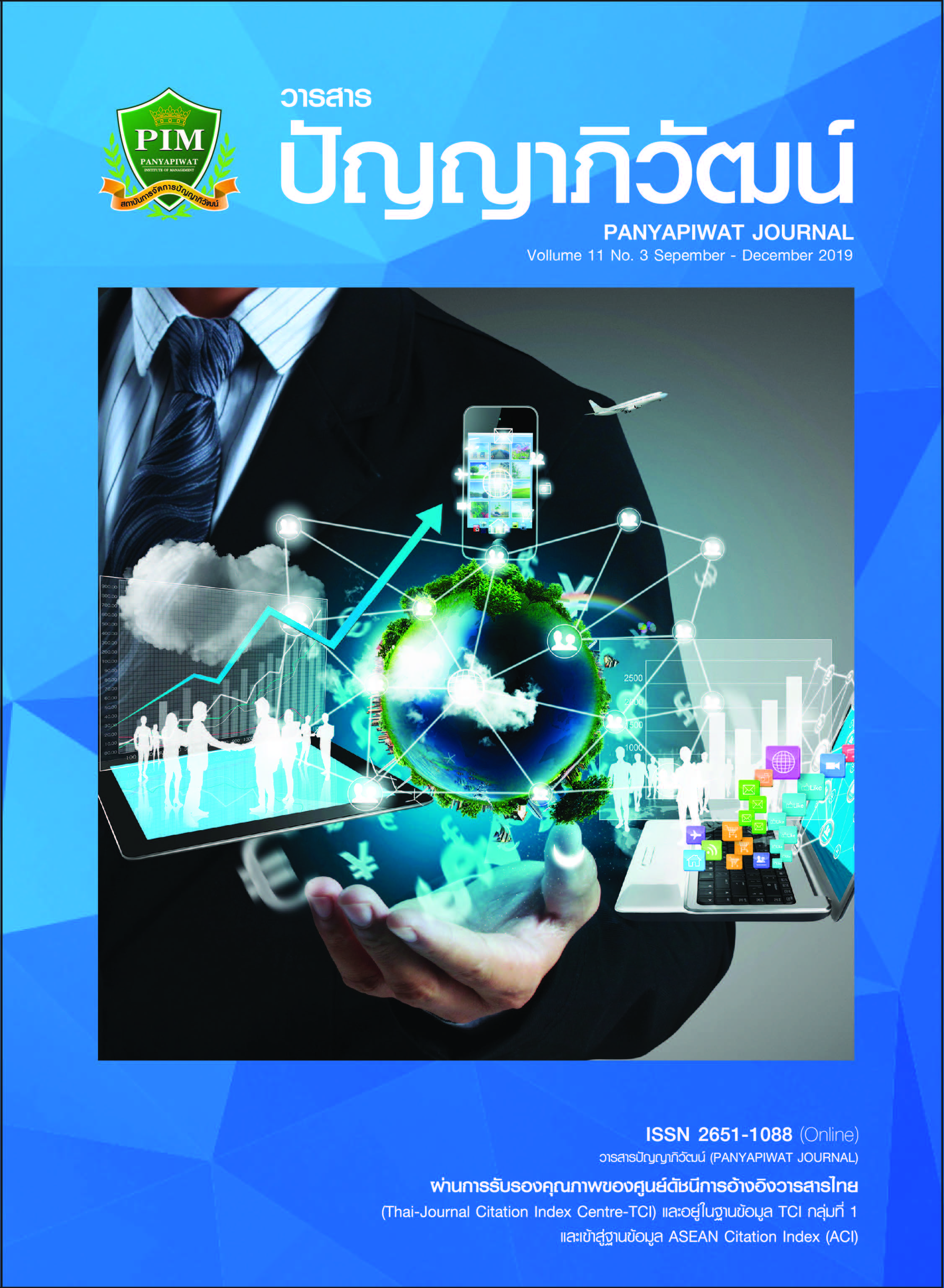ปัจจัยที่อิทธิพลต่อความตั้งใจที่จะใช้บริการกระเป๋าเงินดิจิทัลที่อยู่บนโทรศัพท์มือถือ ในประเทศสาธารณรัฐแห่งสหภาพพม่า
Main Article Content
บทคัดย่อ
วัตถุประสงค์ในการวิจัยครั้งนี้คือ การทดสอบปัจจัยที่มีอิทธิพลต่อความตั้งใจที่จะบริการกระเป๋าเงินดิจิทัลที่อยู่บนโทรศัพท์มือถือในประเทศสาธารณรัฐแห่งสหภาพพม่าโดยใช้แนวคิดแบบจำลองเพิ่มเติมทฤษฏีรวมของการยอมรับและการใช้เทคโนโลยี (UTAUT2) ซึ่งมี 7 ตัวแปรที่เกี่ยวข้อง คือ (1) ความคาดหวังในประสิทธิภาพ (2) ความคาดหวังในความพยายาม (3) อิทธิพลของสังคม (4) สภาพสิ่งอำนวยความสะดวกในการใช้งาน (5) แรงจูงใจด้านความบันเทิง (6) มูลค่าราคา และ (7) ความเคยชิน
การวิจัยครั้งนี้ใช้แบบสอบถามเชิงปริมาณในการศึกษาปัจจัยทั้ง 7 ด้านที่มีผลต่อความตั้งใจความตั้งใจที่จะบริการกระเป๋าเงินดิจิทัลที่อยู่บนโทรศัพท์มือถือในประเทศสาธารณรัฐแห่งสหภาพพม่าโดยใช้การวิเคราะห์การถดถอยเชิงเส้น กลุ่มตัวอย่างที่ใช้ในการสำรวจ มีจำนวนทั้งหมด 496 คน เป็นผู้ที่มีประสบการณ์การใช้บริการกระเป๋าเงินดิจิทัลที่อยู่บนโทรศัพท์มือถือ ผลการวิจัยพบว่าตัวแปร ความคาดหวังในประสิทธิภาพ อิทธิพลของสังคม สภาพสิ่งอำนวยความสะดวกในการใช้งาน และ ความเคยชิน นั้นมีอิทธิพลอย่างมีนัยสำคัญต่อความตั้งใจความตั้งใจที่จะใช้บริการกระเป๋าเงินดิจิทัลที่อยู่บนโทรศัพท์มือถือในประเทศสาธารณรัฐแห่งสหภาพพม่า
Article Details
“ข้าพเจ้าและผู้เขียนร่วม (ถ้ามี) ขอรับรองว่า บทความที่เสนอมานี้ยังไม่เคยได้รับการตีพิมพ์และไม่ได้อยู่ระหว่างกระบวนการพิจารณาลงตีพิมพ์ในวารสารหรือแหล่งเผยแพร่อื่นใด ข้าพเจ้าและผู้เขียนร่วมยอมรับหลักเกณฑ์การพิจารณาต้นฉบับ ทั้งยินยอมให้กองบรรณาธิการมีสิทธิ์พิจารณาและตรวจแก้ต้นฉบับได้ตามที่เห็นสมควร พร้อมนี้ขอมอบลิขสิทธิ์บทความที่ได้รับการตีพิมพ์ให้แก่สถาบันการจัดการปัญญาภิวัฒน์หากมีการฟ้องร้องเรื่องการละเมิดลิขสิทธิ์เกี่ยวกับภาพ กราฟ ข้อความส่วนใดส่วนหนึ่งและ/หรือข้อคิดเห็นที่ปรากฏในบทความข้าพเจ้าและผู้เขียนร่วมยินยอมรับผิดชอบแต่เพียงฝ่ายเดียว”
เอกสารอ้างอิง
Angela, S. (2016). What is a mobile payment? Retrieved August 15, 2018, from https://quat-devtccrocks.cosdevx.com/blog/what-is-a-mobile-payment/
Baumgartner, H. & Steenkamp, J. B. (1996). Exploratory consumer buying behavior: Conceptualization and measurement. International Journal of Research in Marketing, 13(2), 121-137.
Booth, D. & Shepherd, R. (1988). Sensory influences on food acceptance - The neglected approach to nutrition promotion. Nutrition Bulletin, 13(1), 39-54.
Brown, S. & Venkatesh, V. (2005). Model of adoption of technology in households: A baseline model test and extension incorporating house-hold life cycle. MIS Quarterly: Management Information Systems, 29(3), 399-426.
CEIC. (2016). Myanmar number of mobile subscriber. Retrieved October 10, 2018, from https://www.ceicdata.com/en/indicator/myanmar/number-of-subscriber-mobile
Chassat, P. & Foerster, F. (2016). Myanmar banking sector 2025: The way forward. Germany: Roland Berger GmbH. Retrieved August 15, 2018, from https://www.rolandberger.com/en/?country=TH
Cheong, J., Park, M. C. & Hwang, J. (2004). Mobile payment adoption in Korea: Switching from a credit card. Retrieved April 17, 2019, from https://docplayer.net/11273913-Mobilepayment-adoption-in-korea-switching-from-credit-card.html
Cronbach, L. (1951). Coefficient alpha and the internal structure of tests. Psychometrika, 16(3), 297-334.
Fishbein, M. & Ajzen, I. (1975). Belief, attitude, intention, and behavior: an introduc-tion to theory and research. Retrieved November 11, 2018, from https://trove.nla.gov.au/work/ 14275432
Gupta, A. & Dogra, N. (2017). Tourist adoption of mapping apps: A UTAUT2 perspective of a smart traveller. Tourism and Hospitality Management, 23(2), 145-161.
Howard, J. & Sheth, J. (1969). The theory of buyer behavior. Journal of the American Statistical Association, 46, 7-487.
Kinasih, R. (2017). Exploring Myanmar’s economic potential. Retrieved September 1, 2018, from https://ecommerceiq.asia/exploring-myanmar-ecommerce-potential/
Limayem, M., Hirt, S. G. & Cheung, C. (2007). How habit limits the predictive power of intention: The case of information system continuance. MIS Quarterly, 31(4), 705-737.
Lin, H. H. (2017). Mobile money and mobile banking service in Myanmar. Retrieved August 16, 2018, from https://fintechandmyanmar.blogspot.com/2017/07/mobile-money-mobile-bankingservice-in.html
Manaf, N. & Ariyanti, M. (2017). Exploring key factors on technology accept-ance of mobile payment users in indonesia using the modified unified theory of acceptance and use of technology (UTAUT2) model use case: Abc Easy Tap. Retrieved September 26, 2018, from https:// www.iraj.in/journal/journal_file/journal_pdf/14-340-148921185840-44.pdf
Megadewandanu, S., Suyoto, S. & Pranowo, P. (2016). Exploring mobile wallet adoption in Indonesia using UTAUT-2: An approach from consumer perspective. 2016 2nd International Conference on Science and Technology-Computer (ICST). Yogyakarta, Indonesia: Semantic Scholar.
Morosan, C. & Defranco, A. (2016). It’s about time: Revisiting UTAUT2 to examine consumers’ intentions to use NFC mobile payments in hotel. International Journal of Hospitality Management, 53, 17-19.
Nguyen, R. (2017). What to expect in tech this year? Frontier MYANMAR. Retrieved Sepetmber 1, 2018, from https:// frontiermyanmar.net/en/what-to-expect-in-tech-this-year
Oliveira, T., Baptista, G., Thomas, M. & Compas, F. (2016). Understanding the determinants of customer adoption and intention to recommendation the technology. Computers in Human Behavior, 404-414.
Patel, V. (2016). Young consumers’ inten-tion to use mobile wallet services: an empirical investigation. Nirma International Conference on Management (NICOM) 2016, At Institute of Management, Nirma University. Retrieved September 14, 2018, from https://www. researchgate.net/publication/303685121_Young_Consumers’_Intention_to_Use_Mobile_Wallet_Services_An_Empirical_Investigation_Using_UTAUT_Model
Piciarelli, F. (2017). Young people and new technologies: what are the positive aspects? FAMILY and MEDIA. Retrieved April 14, 2019, from https://www.familyandmedia.eu/en/news/young-people-and-new-technologies-what-are-the-positive-aspects/
Stephanie. (2015). Variance inflation factor. Retrieved March 3, 2019, from https://www.statisticshowto.datasciencecentral.com/variance-inflation-factor/
Tao, A. L. (2016). Can mobile tech-nology bring Myanmar in line with other Asean nations?Computer Weekly. Retrieved August 18, 2018, from https://www.computerweekly.com /news/450295982/Can-mobile-technology-bring-Myanmar-in-line-with-other-Asean-nations
The Myanmar Times. (2018). Many are ready to move on from cash: MYANMAR TIMES. Retrieved August 31, 2018, from https://www.mmtimes.com/news/ma-ny-are-ready-move-cash. html
Venkatesh, V., Morris , M., Davis, G. & Davis, F. (2003). User Acceptance of Information Technology: Toward a Unified View. MIS Quarterly, 27(3), 425-478.
Venkatesh, V., Thong, J. & Xu, X. (2012). Consumer Acceptance and Use of Information: Extending The Unified Theory. MIS Quarterly, 36(1), 157-178.
Wave Money. (2015). Background of Wave Money. Retrieved September 15, 2018, from https://www.wavemoney.com.mm/about-us/
Yadav, K. M. (2016). Behavioural intentions to adopt mobile wallets: a developing country’s perspective. Journal of Indian Business Research, 8(3), 227-224.
Yamane, T. (1967). Statistics, An Introductory Analysis (2nd ed.). New York: Happer and Raw.
Yee, C., Qi, N., Young, S., Wee, Y. & Yee, Y. (2015). Factors influencing behav-ioural intention to adopt mobile e-books among undergr -duates: UTAUT2 Framework (Bachelor’s Thesis). Retrieved September 26, 2018, from https://eprints.utar.edu.my/id/eprint/1804
Zainudeen, A. & Galpaya, H. (2015). Mobile phones, internet and gender in Myanmar, London, UK: GSM Association and LIRNEasia. Retrieved September 16, 2018, from https://www.gsma.com/mobilefordevelopment/wp-content/uploads/2016/02/Mobile-phones-internet-andgender-in-Myanmar.pdf
Zeithaml, V. (1988). Consumer perceptions of price, quality, and value: A means-end model and synthesis of evidence. Journal of Marketing, 52(2), 2-22.


